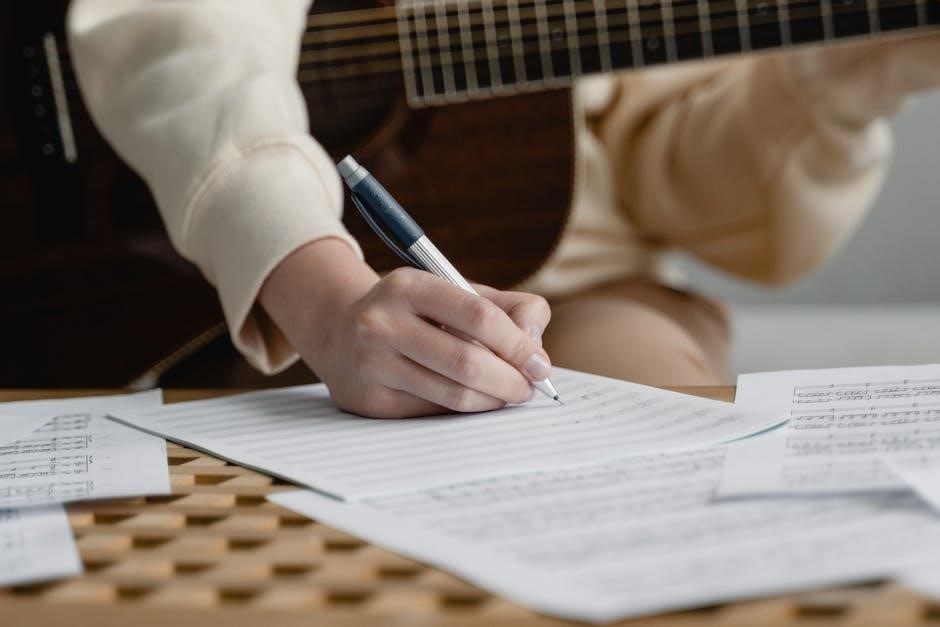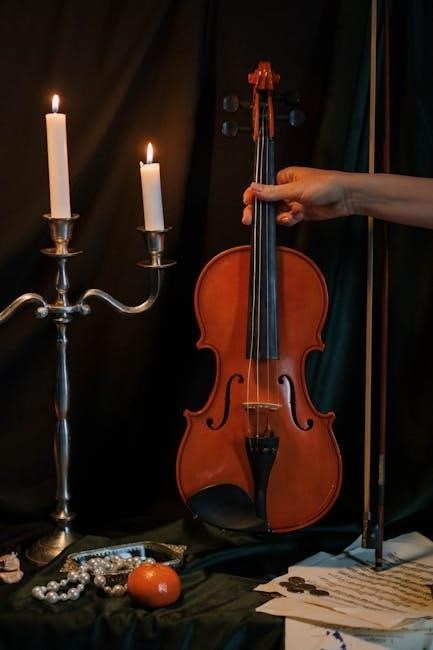The Butterfly Lovers Violin Concerto, composed by He Zhanhao and Chen Gang, is a timeless piece inspired by the Liang Zhu legend․ PDF scores are widely available, blending Chinese folk elements with Western orchestration, making it a cherished work for musicians and enthusiasts․
1․1 Historical Background and Inspiration
The Butterfly Lovers Violin Concerto, composed in 1959 by He Zhanhao and Chen Gang, is deeply rooted in the ancient Chinese legend of Liang Zhu․ This timeless tale of star-crossed lovers has inspired countless adaptations, including this iconic musical interpretation․ The concerto captures the emotional depth and cultural essence of the story, blending traditional Chinese folk elements with Western orchestration․ Its creation marked a significant milestone in the development of Chinese classical music, reflecting the composers’ innovative approach to fusing cultural heritage with modern musical techniques․
1․2 The Legend of Liang Zhu and Its Musical Adaptation
The Butterfly Lovers Violin Concerto is inspired by the ancient Chinese legend of Liang Zhu, a tragic love story about two lovers, Zhu Yingtai and Liang Shanbo, whose devotion transcends death․ Composed by He Zhanhao and Chen Gang in 1959, the concerto captures the emotional depth of the legend through its haunting melodies and expressive orchestration․ The music vividly portrays the lovers’ happiness, separation, and ultimate transformation into butterflies, symbolizing eternal love․ This adaptation has become a cornerstone of Chinese classical music, blending traditional storytelling with modern musical interpretation․
Composers and Their Contribution
He Zhanhao and Chen Gang co-composed the Butterfly Lovers Violin Concerto, blending Chinese folklore with Western orchestration, creating a masterpiece that defines Chinese classical music․
2․1 He Zhanhao and Chen Gang: Biographies
He Zhanhao and Chen Gang are renowned Chinese composers, known for their collaboration on the Butterfly Lovers Violin Concerto․ He Zhanhao studied violin and composition, while Chen Gang focused on piano and composition․ Their partnership uniquely blended traditional Chinese melodies with Western orchestration, creating a work that resonates globally․ Their contribution to Chinese classical music is celebrated, with the concerto becoming a landmark piece in the genre․
2․2 The Collaborative Process Behind the Concerto
The collaborative process between He Zhanhao and Chen Gang was seamless, blending their unique strengths․ He focused on the violin’s expressive qualities, while Chen orchestrated the ensemble․ They drew from the Liang Zhu legend, ensuring emotional depth and cultural authenticity․ Their synergy created a work that harmonizes Eastern themes with Western orchestration, resulting in a timeless masterpiece celebrated worldwide․

Structure and Movements of the Concerto
The Butterfly Lovers Concerto consists of three movements: Falling in Love, Allegro, and Adagio Cantabile․ Each movement reflects the emotional depth of the Liang Zhu story․
3․1 First Movement: Falling in Love
The first movement, Falling in Love, captures the tender encounter between Zhu and Liang․ The melody is lyrical, with the violin expressing their blossoming affection․ PDF scores reveal intricate harmonies blending Chinese folk elements with Western orchestration․ This movement sets the emotional foundation, showcasing the composers’ ability to weave traditional themes into a classical framework․ The interplay between the solo violin and orchestra highlights the delicate beauty of their love story, making it a poignant opening to the concerto․
3․2 Second Movement: Allegro
The second movement, marked Allegro, shifts to a lively and dynamic tempo, reflecting the growing passion and tension in the story․ The violin soloist showcases technical virtuosity, with intricate passages that highlight the instrument’s agility․ PDF scores reveal the interplay between the soloist and orchestra, blending Chinese folk melodies with Western orchestration․ This movement captures the intensity of Zhu and Liang’s relationship, transitioning from joy to impending conflict․ The Allegro’s rhythmic energy and emotional depth make it a compelling contrast to the first movement’s lyrical beauty․
3․3 Third Movement: Adagio Cantabile
The final movement, Adagio Cantabile, is a poignant reflection of the tragic ending of the Liang Zhu story․ The violin delivers a sorrowful, heartfelt melody, accompanied by a mournful orchestral backdrop․ PDF scores highlight the emotional depth, with legato phrases and expressive dynamics․ This movement captures the lovers’ ultimate sacrifice, blending sorrow and beauty․ The soloist’s nuanced performance conveys the profound sadness, while the orchestra underscores the dramatic conclusion․ The Adagio Cantabile remains a touching culmination of the concerto, resonating deeply with audiences worldwide․
Musical Elements and Techniques
The concerto blends Chinese folk melodies with Western orchestration, creating a rich, emotional sound․ PDF scores reveal intricate techniques like legato phrasing and dynamic contrasts, enhancing its musical depth․
4․1 Integration of Chinese Folk Elements
The concerto masterfully incorporates Chinese folk elements, such as pentatonic scales and expressive phrasing, to evoke traditional musical storytelling․ The solo violin mimics the vocal styles of Chinese opera, while orchestral arrangements imitate the timbres of traditional instruments like the erhu and pipa․ These elements blend seamlessly with Western orchestration, creating a unique sound that honors China’s cultural heritage․ The PDF scores highlight these techniques, making the concerto a landmark in fusing Eastern and Western musical traditions․
4․2 Western Orchestration and Instrumentation
The Butterfly Lovers Violin Concerto is scored for a full Western-style symphony orchestra, featuring strings, woodwinds, brass, and percussion․ The solo violin is accompanied by rich harmonic textures and dramatic orchestral crescendos, showcasing the interplay between the soloist and the ensemble․ Western orchestration techniques, such as modulation and thematic development, are employed to enhance the emotional depth of the piece․ The concerto’s structure and instrumentation reflect a balance between Eastern melodic motifs and Western symphonic traditions, creating a dynamic and expressive musical landscape․
Availability of Sheet Music and PDF Resources
Sheet music and PDF resources for the Butterfly Lovers Violin Concerto are widely available online, including solo parts and full scores, for both violin and adapted instruments․
5․1 Where to Find the Full Score and Solo Part
The full score and solo part of the Butterfly Lovers Violin Concerto can be found online in PDF format․ Websites like MuseScore and other sheet music repositories offer free downloads․ Specific files such as “Butterfly-Lovers-Yang-Xuefei․pdf” and “Butterfly_Lovers_WIP․pdf” are available for solo violin and adapted instruments․ Some platforms require a premium subscription for full access․ These resources are easily accessible, making the concerto widely available for musicians and enthusiasts to enjoy and perform․
5․2 Adaptations for Different Instruments
Adaptations of the Butterfly Lovers Violin Concerto are available for various instruments․ The concerto has been transcribed for oboe, flute, and piano, expanding its accessibility․ For instance, the oboe adaptation retains the emotional depth of the original․ Similarly, a piano-violin arrangement by Shuwen Zhang offers a duet version․ These adaptations are widely available in PDF format, making the piece reachable to a broader audience․ They allow musicians to explore the concerto’s beauty across different instrumental settings, ensuring its timeless appeal endures․

Performances and Interpretations
The Butterfly Lovers Violin Concerto has been performed by renowned artists like Gil Shaham and Lan Shui, showcasing its emotional depth․ Notable renditions highlight the piece’s expressive qualities, making it a favorite in orchestral repertoire․
6․1 Notable Performances and Artists
Renowned artists like Gil Shaham and Lan Shui have delivered exceptional performances of the concerto, captivating audiences worldwide․ Sha’s solo with the Shanghai Symphony Orchestra marked the 40th anniversary, highlighting the piece’s enduring appeal․ The work’s emotional depth and technical challenges attract top virtuosos, ensuring its place in classical music repertoire․ These performances showcase the concerto’s ability to blend Chinese folklore with Western orchestration, creating a timeless experience for listeners and solidifying its legacy as a masterpiece of contemporary classical music․
6․2 Variations and Arrangements Over Time
The concerto has inspired numerous adaptations, including arrangements for oboe, flute, and piano, as well as duet versions․ A slower version for educational purposes has been created, aiding musicians in mastering the piece․ Additionally, arrangements by artists like Shuwen Zhang and Shengyou Guan have expanded its reach․ These variations highlight the work’s versatility, making it accessible to diverse instrumentalists while preserving its emotional core․ Such adaptations ensure the concerto remains relevant and cherished across generations and musical styles, fostering a broader appreciation of its beauty․

Cultural Impact and Legacy
The Butterfly Lovers Violin Concerto has won international acclaim, becoming a landmark in Chinese classical music․ Its global recognition highlights the fusion of Eastern and Western musical traditions․
7․1 Influence on Chinese Classical Music
The Butterfly Lovers Violin Concerto has profoundly influenced Chinese classical music by blending traditional folk elements with Western orchestration․ It became a landmark, inspiring future composers to fuse cultural heritage with modern techniques․ The concerto’s emotional depth and technical complexity have set a high standard, encouraging musicians to explore similar fusions․ Its success bridged cultural gaps, showcasing Chinese storytelling through music globally․ This work remains a cornerstone, preserving traditions while modernizing classical music in China․
7․2 Global Recognition and Appreciation
The Butterfly Lovers Violin Concerto has gained global acclaim for its emotional depth and unique fusion of Chinese folklore with Western orchestration․ Performances by renowned artists like Gil Shaham and orchestras worldwide have showcased its universal appeal․ Its availability in PDF formats has made it accessible to musicians globally, fostering appreciation across cultures․ The concerto’s ability to transcend cultural boundaries has made it a beloved piece, introducing Chinese musical traditions to international audiences and solidifying its place as a masterpiece of global classical music․

Resources for Learning and Practice
PDF scores of “The Butterfly Lovers Violin Concerto” are widely available online, offering detailed sheet music and arrangements․ Tutorials, guides, and recordings provide valuable resources for musicians and enthusiasts to study and master this iconic piece․
8․1 Tutorials and Guides for Musicians
Tutorials and guides for “The Butterfly Lovers Violin Concerto” are readily available online, offering detailed insights for musicians․ PDF scores provide precise notation, while video tutorials demonstrate techniques for mastering the concerto’s intricate passages․ Many resources cater to both beginner and advanced levels, ensuring comprehensive learning․ Additionally, guides often include historical context and interpretative tips, enhancing the musician’s understanding and performance quality․ These tools are invaluable for anyone aiming to excel in this beloved piece․
8․2 Recordings and Videos for Study
Recordings and videos of “The Butterfly Lovers Violin Concerto” are abundant online, offering invaluable resources for study․ Performances by renowned artists like Gil Shaham and Lan Shui provide inspiration and insight․ Video tutorials and masterclasses detail techniques for mastering the concerto’s challenging passages․ Additionally, recordings on platforms like YouTube and Spotify allow musicians to analyze interpretations and phrasing․ These resources are essential for both beginners and advanced players seeking to refine their understanding and execution of the piece․